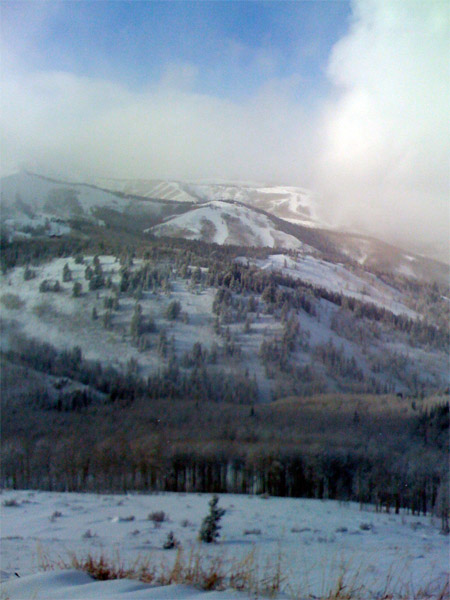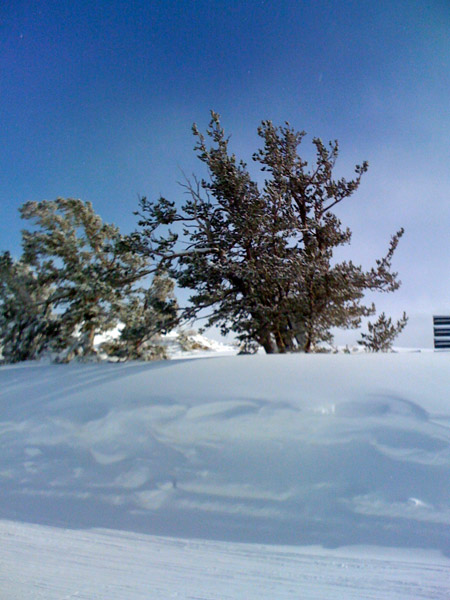Born and raised in Colorado, I am somewhat particular to skiing in Colorado, and when I head west for a ski trip I usually land somewhere along the I-70 corridor in the Rocky Mountains.
It’s hard to go wrong skiing in Colorado. There are so many excellent resorts to choose from, and their seasons are long and full of bountiful snow. After a several year drought from western skiing, I aimed my sights right on Vail for a mid-December ski trip.
So it was with some irony that I drove right past Vail, and right out of Colorado -; into neighboring Utah. There’s no need to panic -; I’ll be lingering in Colorado on the way back to Denver -; but this provided a chance to check out the Salt Lake City region and sample some of that Utah powder we hear so much about.
Time to lay on the irony: Utah hasn’t had all that much powder so far this winter.
In fact, it’s been downright brutal. Most ski areas in the Park City region have had to rely on snowmaking to open. And guess what -; compared to mid-Atlantic snowmaking, these resorts are neophytes. They have quaint snowguns -; the type that require manual adjustments and lots of loud, compressed air. We might have base elevations that start near sea level, a compressed season that seems like it’s over before it starts, and more rain (uh, undeveloped snow) than natural snow, but there’s one thing we know how to do in the mid-Atlantic: make snow. We’ve got fancy computerized snowmaking systems that make more snow with less energy. Necessity breeds competency, and we’re nothing if not competent at making artificial snow.
Which brings me back to Utah. In a typical year, Utah ski areas will receive oodles of natural snow (where “oodles” is defined as “more feet than you can count”). So they don’t need to rely on snowmaking, and only cover a small percent of slopes with snowmaking infrastructure. Normally that’s not a problem, but this year, natural snow has been slow to arrive.
So, time for some more irony: Up until this past weekend, The Canyons, a goliath of a Utah ski area if there ever was one, had four trails available for your skiing or boarding pleasure. (DCSki’s J.R. Patten will provide a Firsthand Report from The Canyons in the near future.) Whitetail had over twice as many trails open. (OK, Whitetail’s trails are perhaps shorter.)
So the early season has not been good to Utah, but a winter storm arrived just as I was driving into Salt Lake City, dumping a few inches of fresh powder on the Wasatch Range. That covered open slopes with some nice powder, and allowed Park City ski areas to inch their trail count up.

|
|
A chilly afternoon of skiing at Deer Valley Resort. Photo provided by M. Scott Smith.
|
For my first time skiing in Utah, I decided to spend an afternoon at Deer Valley. Deer Valley is located in Park City, and has been rated by Ski magazine readers as the #1 ski resort in North America for two years running (take that, Whistler!).
Deer Valley opened in 1981, and if one word sums up the resort, it’s “service.” The resort has been a pioneer in bringing unrivaled customer service to every aspect of ski area operations, and you experience this firsthand from the rental shop to the ticket window to the lift attendants to the valets that help you pull your gear out of the car.
Deer Valley is also known for its attention to grooming. Although, to be honest, on this day I could not tell any difference between the slope conditions at Deer Valley and every other western ski area I’ve been to on a good snow day: nothing to complain about, but no outer body experience, either.
There is one other thing Deer Valley is known for, but I had forgotten this fact until it suddenly occurred to me, an hour into skiing, that something was missing: snowboarders.
In 2008, over 40 years after the first snowboard met snow, Deer Valley still does not allow snowboarders on its slopes. This made the experience somewhat surreal, like I had traveled in a time machine to a period where snowboarding didn’t exist, but high-speed lifts and state-of-the-art lodges did! It was very strange, not hearing the distinct scrape of snowboards carving against snow. But I kind of liked it.
New Mexico’s Taos Resort also banned snowboarding -; until very recently. Taos began allowing snowboarders on March 19, 2008, perhaps after someone pointed out that snowboarders make up half or more of lift ticket sales these days.
Deer Valley is not alone in banning snowboarders, but its company is shrinking. Vermont’s Mad River Glen also does not permit snowboards on its ski slopes.
There are plenty of other ski areas in Park City -; within a few minutes drive -; that do allow snowboarding, so there were not snowboarders picketing at the bottom of the slopes. I did notice that the clientele consisted largely of families and older folks. Deer Valley is definitely a family-friendly resort.
I arrived just past noon, content with spending a half day on the slopes for my first ski day of the season. This worked out nicely, because Deer Valley offers half-day rentals and lift tickets. I had brought my own boots, so I rented performance skis and poles for $38, and also bought a half-day lift ticket, valid from 12:30 to 4:15 p.m. It only took a few minutes to get the rentals and get on the slopes.
The parking lot was pretty full, so I was afraid one of the first major snowstorms of the season would draw a lot of Sunday visitors to Deer Valley’s slopes. But the resort was not crowded at all. There were never more than a few people in front of me in a lift line.
Deer Valley had about 12 trails open (out of 99), but the trails were spread throughout the resort, and were nice and long, so there was plenty of variety and it didn’t seem like most of the resort was closed. The open trails comprised a lot of skiable acres.

|
|
Deer Valley receives some much-needed natural snow December 13-14, 2008. Photo provided by M. Scott Smith.
|
Snow continued to fall throughout the afternoon, although often the snow was falling on the bottom portions of the mountain, while blue sky poked through the clouds at the top of the mountain. It was pretty cold -; the temperature hovered in the low teens, but felt much colder at times, due to a gusty wind.
I made the mistake of storing my boots in a sub-freezing rental car overnight, and they didn’t have time to warm up before I put them on. After a few runs, I noticed that I could no longer feel my toes. This didn’t seem good, so I headed into one of Deer Valley’s mountain lodges -; and it was a great place to relax and warm up. There were lots of tables with checker and chess games on them, and even a 20-foot high gingerbread house, courtesy of one of the chefs. The bathroom had rolled up towels to dry your hands with; when you were done you dropped the towel in a laundry basket. I’ve never seen that at a ski area before.
Soon a sharp pain starting shooting through my toes, confirming my suspicion that I was on the cusp of frostbite. Probably a good thing I swung by the lodge! After warming up my toes, I was back on the slopes. My feet stayed warm the rest of the afternoon, but my exposed face and neck were often chilly, being blasted by a frigid cold air. It truly is a puzzle figuring out how to dress properly for a day of skiing; I have yet to perfectly solve that puzzle, especially on the coldest of days.
I took run after run, sticking mostly to blue intermediate cruisers (not that there was much choice.) I tend not to read trail maps; I just explore. Sometimes that lands me in trouble, and it did this afternoon. Somewhere around the middle of the ski area, I hopped on the Silver Lake Express lift to see where it goes. (Little did I know at the time that I had taken the very same lift at the start of my skiing, from the base lodge on up the mountain.) The end of the Silver Lake Express starts by going up, so this seemed like a good lift to board. And then after cresting a hill (with some fancy slopeside mansions that would be fun to, say, own), the lift began going downhill. “Cool,” I thought, expecting it to soon start going uphill again.
But it didn’t. It continued downhill all the way to the base of the mountain, becoming a cold lift ride of shame.
Oops.
There was probably a sign to this effect at the top.
When I off-loaded at the bottom, I looked a bit confused and started walking towards the adjacent Carpenter Express Lift, although there were ropes blocking the way. Some helpful employees guessed at my error and said “you want to go back up, don’t you?”, opening the ropes and letting me through. I am sure this happens a lot.
Around 4 p.m., I decided to call it a day, thankful for my first runs of the season and glad that I remembered how to ski. Admit it: after long summer months of no skiing, each time you hit the slopes for the first time each winter, you begin wondering on the first lift ride up if your legs will remember what to do when you offload the lift. Well, I do, anyway.
It was nice to see Deer Valley, a ski area that served as an inspiration to our own Whitetail Resort. (The original developers of Whitetail toured ski areas across the country to sample “best practices,” using what they learned to influence the design and operation of Whitetail. The base lodge at Whitetail is modeled after the architecture of Deer Valley, and we can thank Deer Valley for services such as free ski check, too.)
If you’re in Park City, it’s worth spending a day -; or week -; skiing at Deer Valley. You’ll feel pampered, and enjoy the positive attitude of all the employees. And there are lots of great trails, too. (Some day, I’ll have to check out the 87 I missed!) If you get bored, other ski areas such as The Canyons, Park City Mountain Resort, or Alta are not that far away. If you don’t mind a short drive (about half an hour), you can use Salt Lake City as your base; lodging is quite affordable in the winter. I stayed at the Hilton Garden Inn in downtown Salt Lake City; it’s currently rated the #1 hotel in Salt Lake City on TripAdvisor, and I concur with that rating -; it’s new and clean and has great amenities. I was able to get a room for about $94 a night.
M. Scott Smith is the founder and Editor of DCSki. Scott loves outdoor activities such as camping, hiking, kayaking, skiing, and mountain biking. He is an avid photographer and writer.